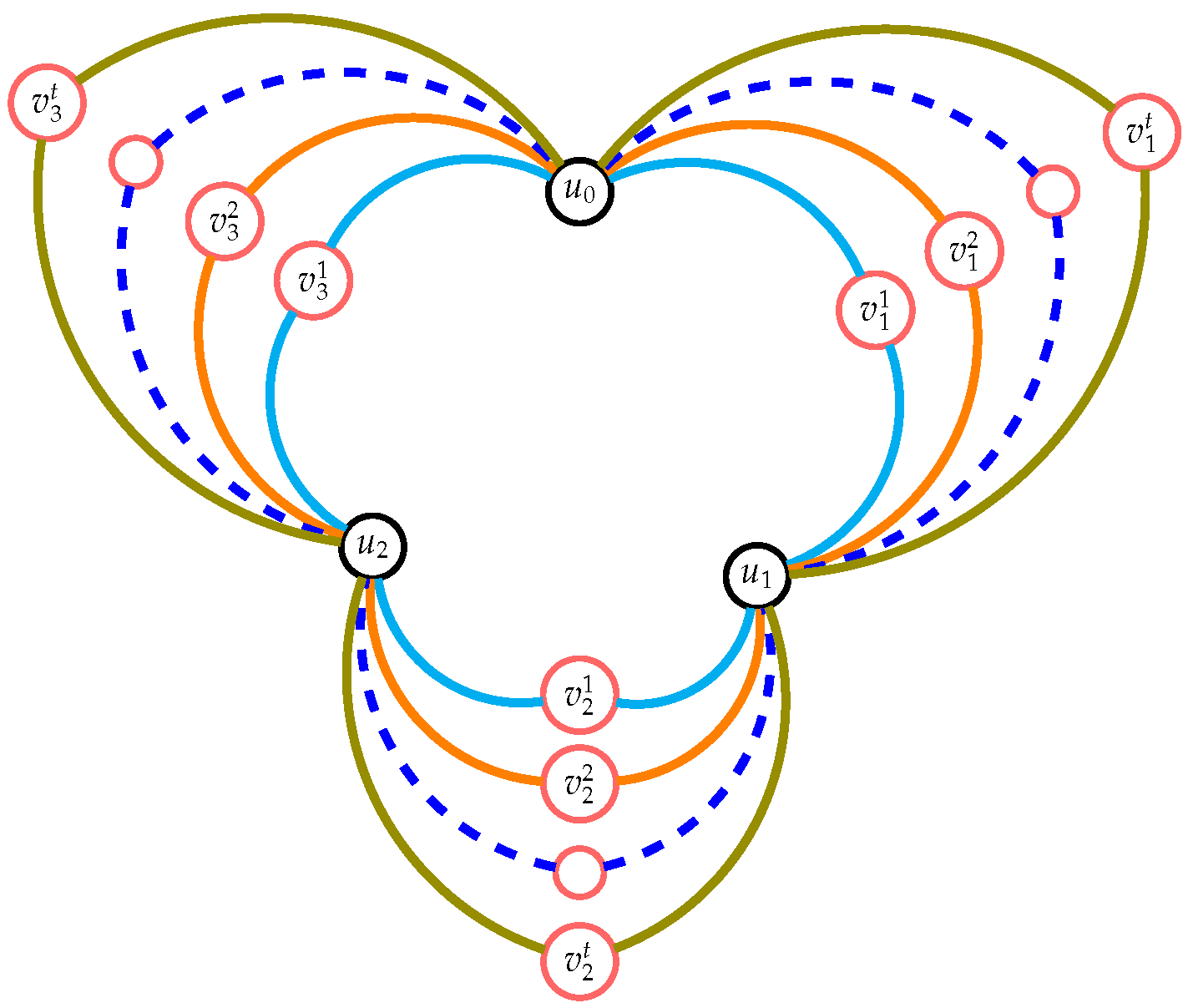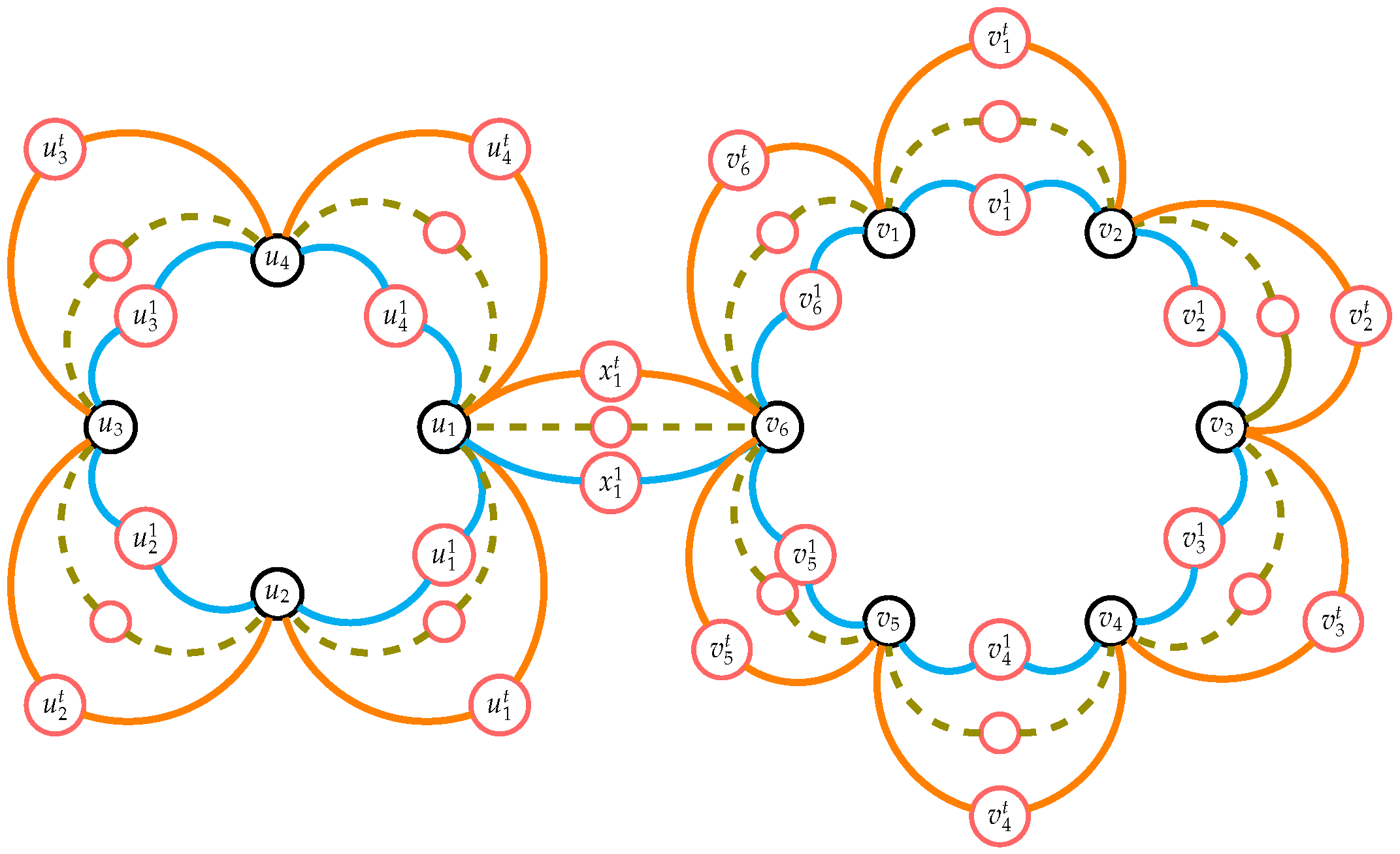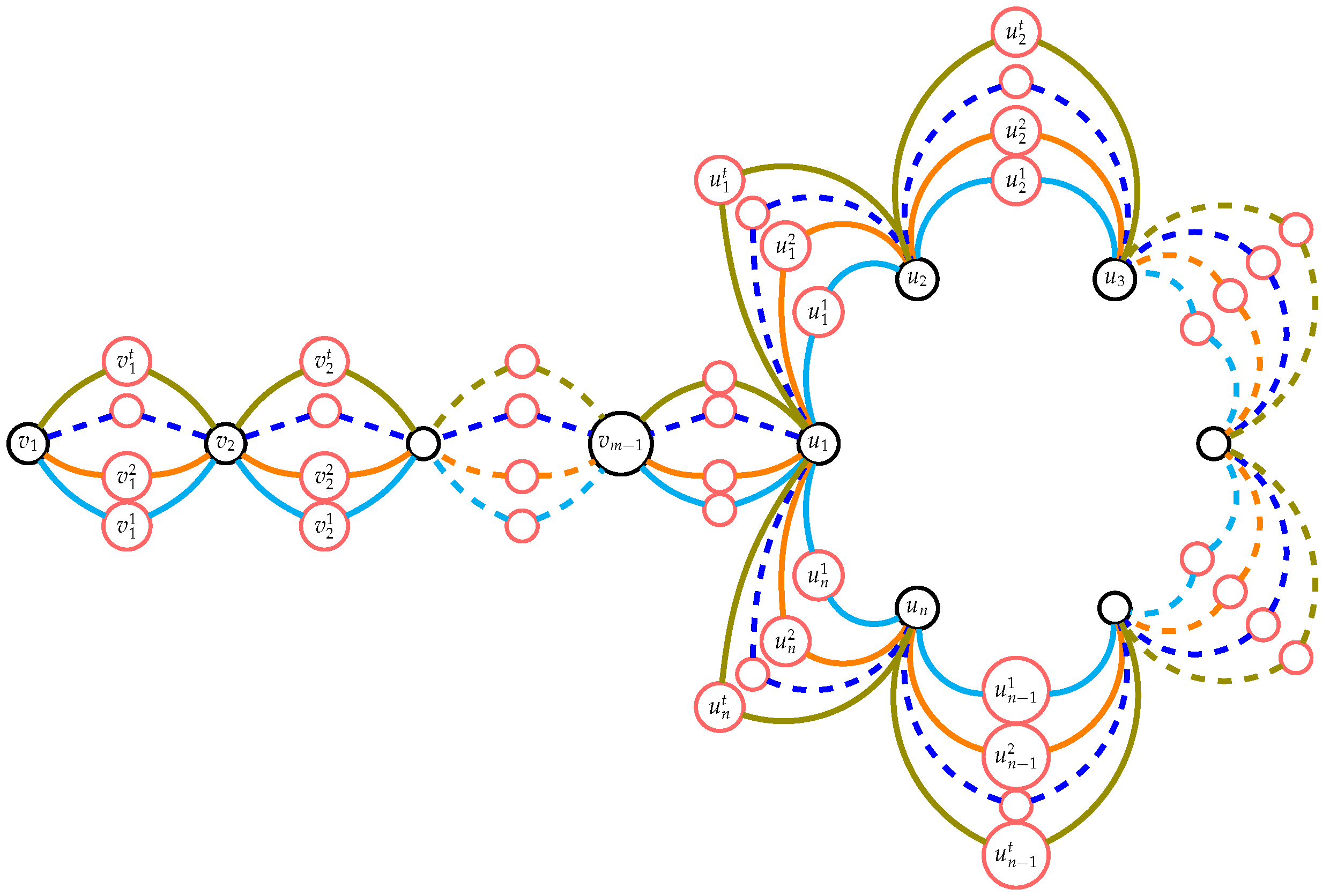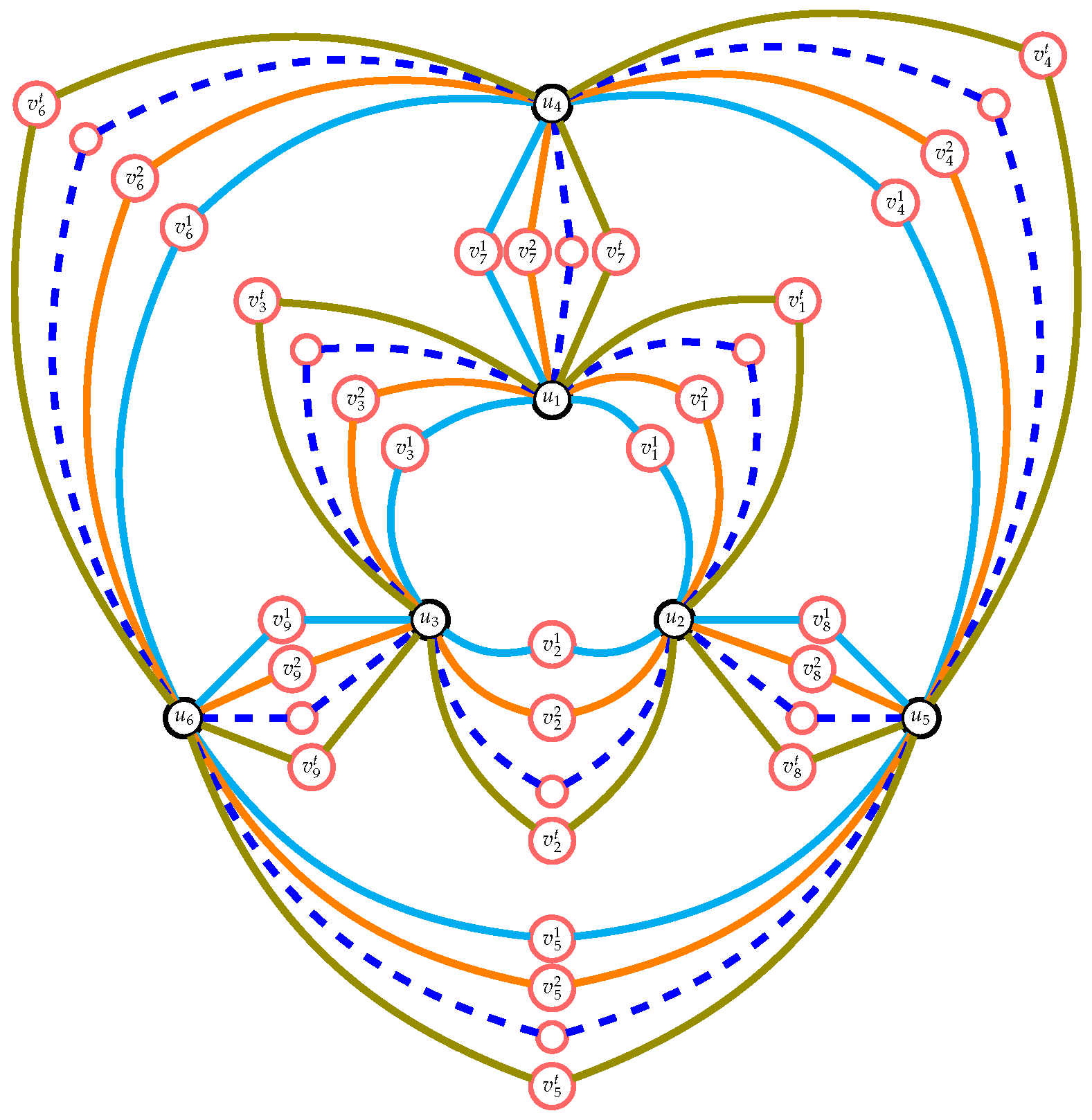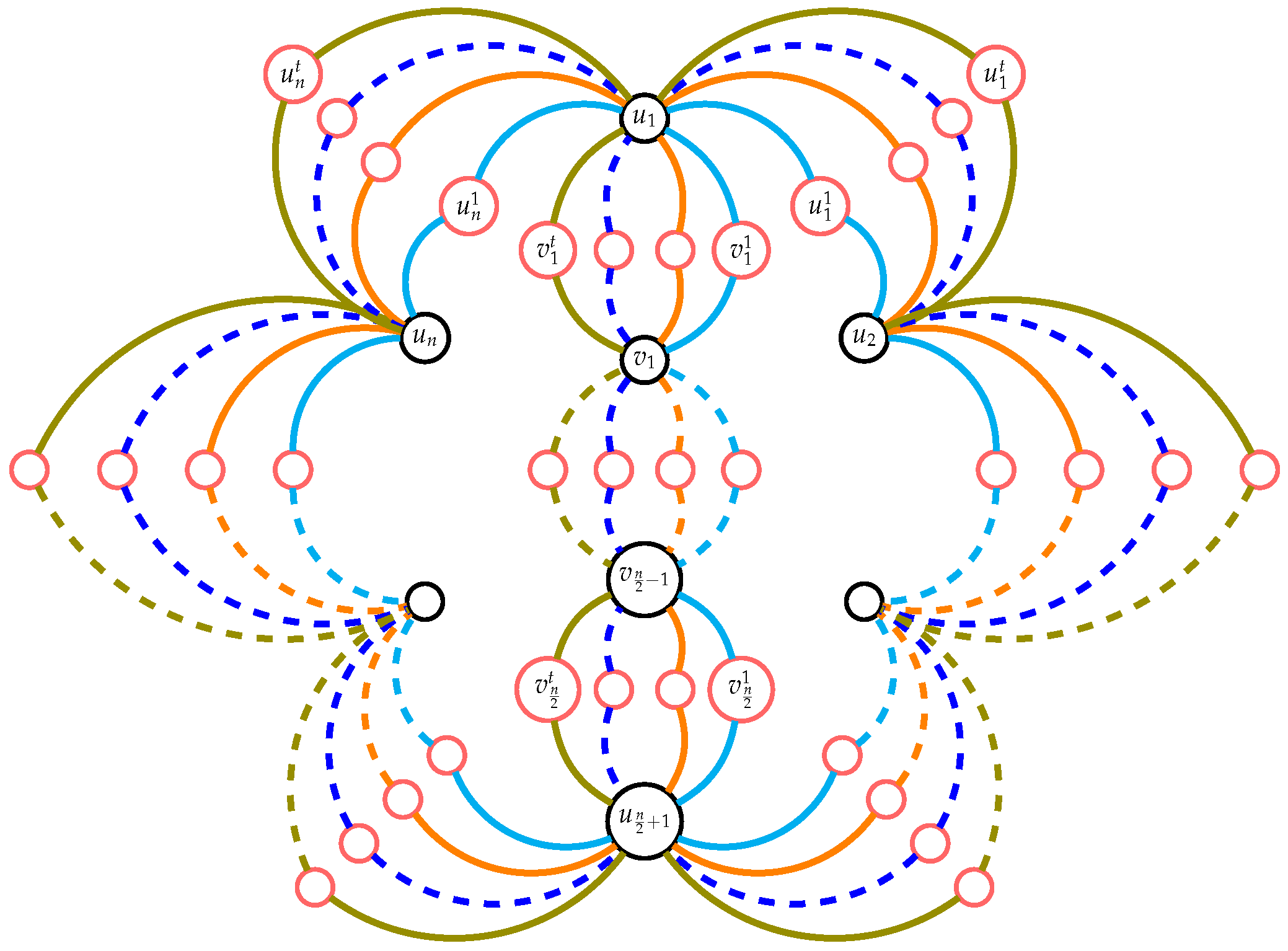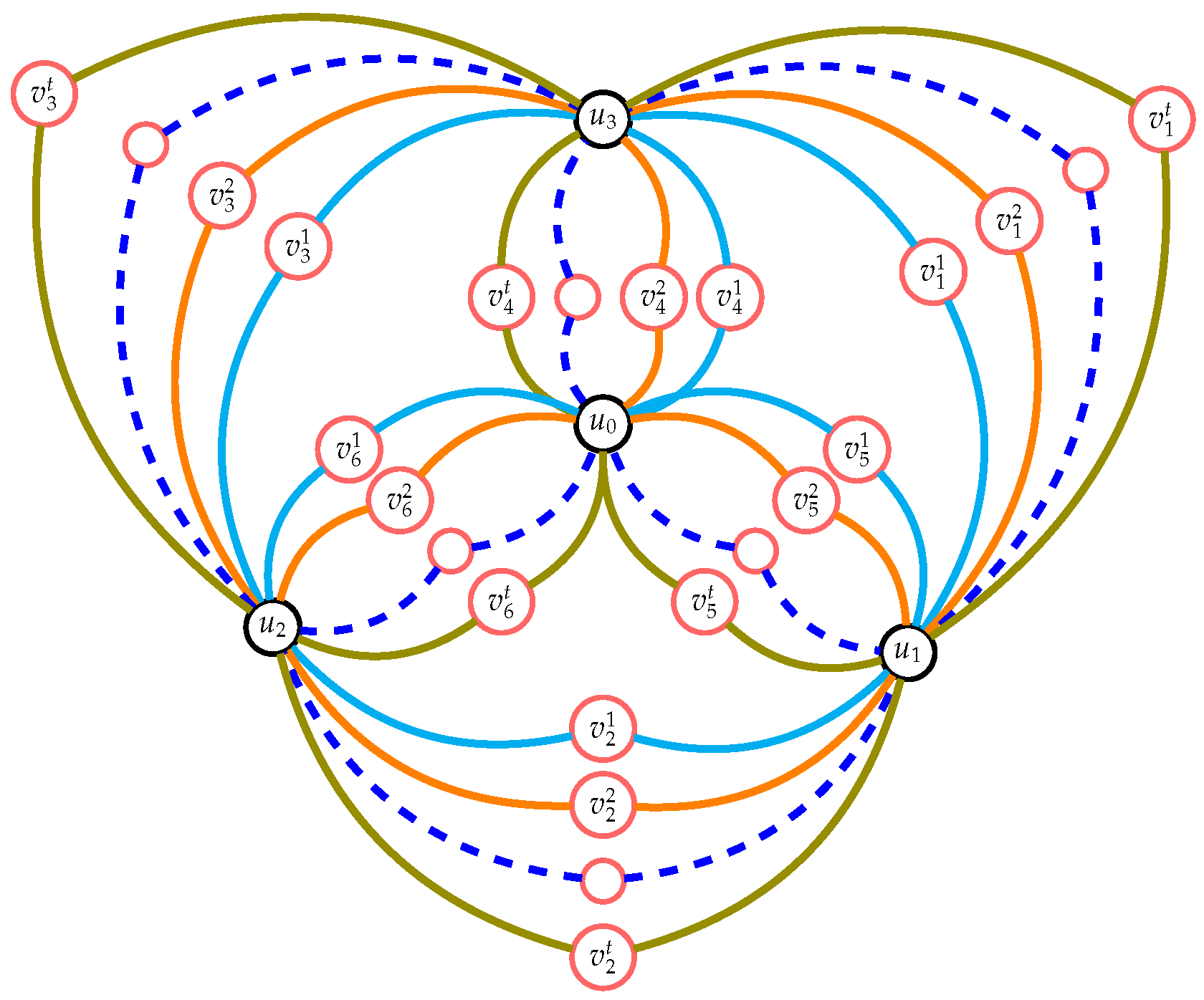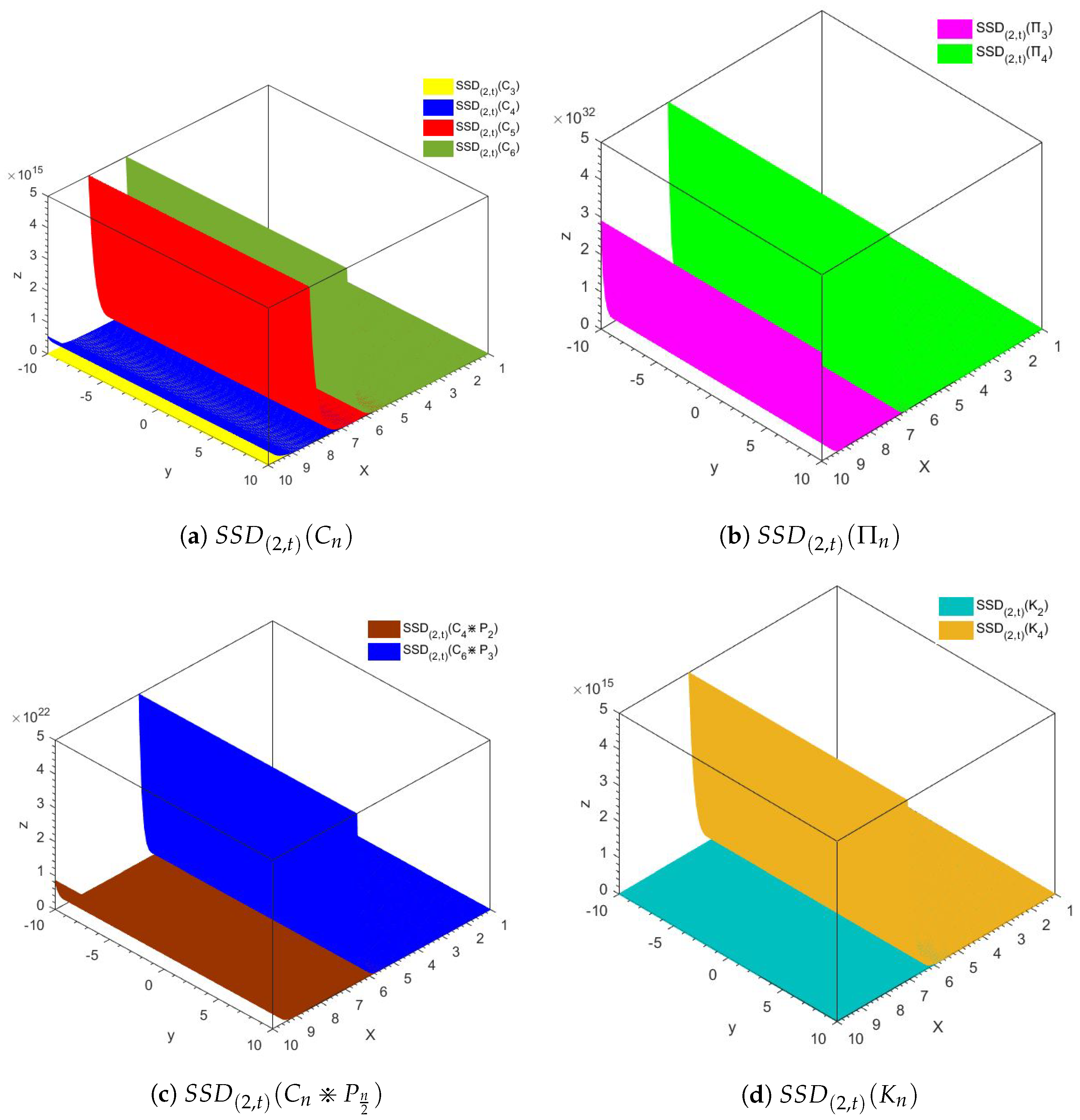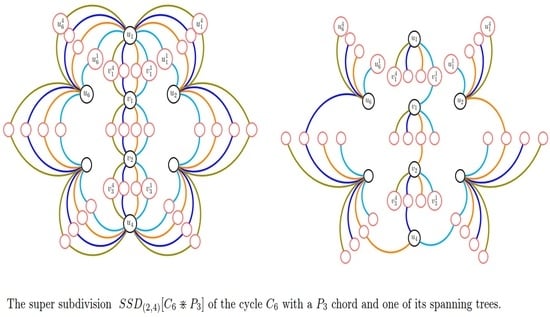1. Introduction
Graph theory is a theory that merges mathematics with computer technology. For a simple, undirected and connected graph
,
a spanning tree is a subset of the edges of
that connect all the vertices together without any cycles [
1].
The complexity of
, denoted by
, is the total number of spanning trees existent therein. It is used to calculate the connected and acyclic components that are present in it. Spanning trees are well recognised, and several studies have been conducted to prove their existence and count all of their numbers. One can introduce the complexity function
for an infinite family of graphs
which makes it much easier to calculate and identify the number of corresponding spanning trees, especially when these numbers are very large. The number of spanning trees is employed in a variety of fields, including engineering and network reliability. This invariantly contributes to enhancing the robustness of wireless sensor networks (WSNs) and other analogous mobile networks. The security plan for a building’s sensitive area is an example of another way complexity is used.
One of the biggest chemistry challenges is correctly recognising a chemical molecule. In [
2], Joita et al. introduced graph representations of molecules as well as answers to questions about relationships between the structure of chemical compounds and various parameters. The number of spanning trees is employed in the field of chemistry. In [
3,
4], Nikolić et al. studied the complexity of molecules using approaches based on the topological complexity, that is, the complexity of the corresponding molecular graphs. Several measures of the topological complexity, such as those introduced by Bertz and Randić or based on the number of spanning trees, have been studied and a comparison was made between these measures of topological complexity for selected molecular graphs. For more details, please refer to [
5,
6,
7].
A different way of displaying and condensing data from graphs is via matrices. The same information is contained in both a matrix and a graph, but a matrix is more effective for computing and computer analysis [
8]. Given a graph
with
, the
adjacency matrix of
denoted by
is a
matrix defined as follows. The rows and the columns of
are indexed by
. If
, then the
-entry of
is 0 for nonadjacent vertices
ℓ and
m, and the
-entry is 1 for adjacent
ℓ and
. The
-entry of
is 0 for
, i.e.,
The
degree matrix [
8]
D for
is a
diagonal matrix defined as
where the vertex’s degree
is the number of times an edge ends at that vertex.
The Laplace matrix of
denoted by
is defined as
. It is well known that
is a positive semidefinite matrix with the smallest eigenvalue 0. Kirchhoff presented the first method to calculate the number of spanning trees defined as the matrix tree theorem [
9], which says that all the cofactors of
L are equal and their common value is equal to the complexity
of
.
Temperley [
10] has shown that
where
J is a
matrix, all of whose elements are ones.
Brownaj et al. [
11] applied various methods to calculate the complexities of graphs that represent fullerenes (
,
and
molecules). These graphs are large, regular and highly symmetrical. Kirby et al. [
12] presented a theorem called the cycle theorem, by means of which the complexity of a labelled planar or non-planar graph may be calculated from, in general, two determinants. These are much smaller than in the traditional matrix tree theorem. They applied this theorem to a conventional toroidal polyhex.
The contraction–deletion theorem is one of the most often used techniques for determining complexity. The complexity
of a graph
is equal to
, where
x is any edge of
,
is the deletion of
x from
and
is the contraction of
x in
. This provides a recursive way to determine how complex a graph is, see [
13].
Another significant technique is using electrically equivalent transformations of networks. Zhang et al. [
14] discovered a clear-form formula for the enumeration of spanning trees of the subdivided line graph of a simple connected graph using the theory of electrical networks. Teufl and Wagner [
15] have demonstrated that the number of spanning trees in a network only varies by a factor if any of its subnetworks are replaced by an electrical equivalent network. This is crucial information that makes it simple to calculate the number of spanning trees in a network [
16].
Zeen El Deen et al. [
17] created a clear computation of the complexity of a duplicate graph using the splitting, shadow, mirror and total operations of a certain family of graphs. The authors presented nine network designs in [
18], built using squares of various average degrees, and established a more precise, simple formula for the number of spanning trees in each of these networks. In [
19], Zeen El Deen examined the complexity of several classes of prisms of graphs with connections to paths and cycles. For several families of graphs, counting and maximising the number of spanning trees has recently been the subject of numerous studies [
20,
21,
22,
23,
24,
25].
The complement of a graph is a graph on the same vertices such that two distinct vertices of are adjacent if and only if they are not adjacent in . That is, to create the complement of a graph, one removes all edges that were previously there and adds all edges that are needed to build a complete graph.
Lemma 1 ([
26]).
Let Γ be a graph with κ vertices. Then,where are the degree and adjacency matrices, respectively, of , where is the complement of Γ.
A matrix that has been broken up into blocks that are themselves matrices is known as a block matrix. The matrix is divided by making one or more vertical or horizontal cuts across it [
27]. Block matrices are crucial for determining the number of spanning trees in graphs.
Lemma 2 ([
28,
29]).
Suppose and Ψ are block matrices of dimension and Φ is invertible. Then, Lemma 3 ([
8]).
Let be the circulant matrix given by, then .
Graph operations [
30] create new graphs from old ones; the super subdivision operation is employed currently.
Definition 1. In a complete bipartite graph , the part consisting of two vertices is referred as the two-vertex part of and the part consisting of t vertices is referred as the t-vertex part of .
Definition 2. Let Γ be a graph. The super subdivision of , denoted by , is a new graph obtained from Γ by replacing every edge of Γ with a complete bipartite graph in such a way that the end vertices of each edge in Γ are merged with the two vertices of two-vertex part of after removing the edge from .
2. Complexity of the Super Subdivision Graph
Lemma 4. Suppose and are block matrices, and .
Then,
Proof. Utilising the characteristics of matrix row and column operations leads to
□
Lemma 5. Suppose and are block matrices, and
Then, .
Proof. The results of employing the row and column characteristics of a matrix are as follows:
□
2.1. Complexity of the Super Subdivision Graph
Theorem 1. For any positive integer , the number of spanning trees of the super subdivision graph of the cycle is given by:
Proof. Let
be a cycle with vertex set
. The super subdivision graph
of
has a vertex set
. Thus, the graph
has
vertices and
edges, see
Figure 1.
Using Lemma 1, we get the following:
From Lemma 5, we have,
where
and
is a matrix with the same value in all entries in which
, then,
Using matrix row and column operations and determinant characteristics, the following results are obtained:
Substituting Equations (
4)–(
6) in Equation (
3), we obtain the result. □
2.2. Complexity of the Super Subdivision Graph
Theorem 2. For any positive integer , the number of spanning trees of the super subdivision graph of the cycle is given by:
Proof. Using the same approach as in Theorem 1, we have:
From Lemma 2, we have,
where
,
in which
, and
in which
.
Performing
and
, we have
Lemma 3 provides us with,
Substituting Equations (
8)–(
11) in Equation (
7), we obtain the result. □
2.3. Complexity of the Super Subdivision Graph
Theorem 3. For any positive integer , the number of spanning trees of the super subdivision graph of the cycle is given by:
Proof. Using the same technique as in Theorem 1, we have:
where
in which
and
in which
A straightforward calculation reveals that:
and
in which
, then
in which
.
Substituting Equations (
13)–(
15) in Equation (
12), we obtain the result. □
2.4. Complexity of the Super Subdivision Graph
Theorem 4. For any positive integer , the number of spanning trees of the super subdivision graph of the cycle is given by:
Proof. Using the same approach as in Theorem 1, we have:
Applying Lemma 4 and Lemma 5, we have
where
,
in which
and
in which
From substituting Equations (
17)–(
21), in (
16), we obtain the result. □
2.5. Application
2.5.1. The Dumbbell Graph
Theorem 5. For any positive integer , the number of spanning trees of the super subdivision graph of the complete graph is given by:
Proof. Applying Lemma 1, we obtain:
□
Definition 3. The graph created by joining two disjoint cycles and with an edge is called a dumbbell graph
, represented by . The super subdivision of the dumbbell graph is represented in Figure 2. Definition 4 ([
13]).
By , we mean the union of two graphs and that share a single vertex, , on their common external face. Using Theorem (2.4) in [
13] which states that if the graphs
have a common vertex in the external face, then
, then we have the following theorem:
Theorem 6. For any positive integer , then
Proof. Using Theorems 1–5, we obtain:
- (i)
.
- (ii)
.
The proofs of (iii–x) follow similarly, as in (i–ii). □
2.5.2. The Dragon Graph
The dragon graph, represented by
, is created by matching vertex
of the path
with vertex
of a cycle graph
. The vertex set of
is
. The super subdivision graph
of the dragon graph has a vertex set
. As a result, the graph
has
vertices and
edges, see
Figure 3.
Theorem 7. For any positive integer , the number of spanning trees of the super subdivision graph of the path is given by: .
Proof. Let
be the path with vertex set
. The super subdivision graph
of the path
has a vertex set
. As a result, the graph
has
vertices and
edges. Using Theorem 5, we obtain:
. □
Theorem 8. For any positive integer , then
Proof. Using Theorems 1–4 and Theorem 7, we obtain:
- (i)
Since
, then
- (ii)
Since
, then
The proofs of (iii–iv) follow similarly, as in (i–ii). □
3. Complexity of the Super Subdivision Graph of the Prism
Let be a cycle and be a copy of . The prism is constructed by joining each vertex of to the corresponding vertex of for all , the edge set is . Thus, and .
Lemma 6. Suppose and are block matrices and Proof. The row and column properties of matrices are applied to the matrix and the following operations are performed consecutively:
- (1)
Subtracting from , from , and from ;
- (2)
Adding to , to , and to ;
- (3)
Subtracting from ;
- (4)
Adding to ;
- (5)
Expanding along ;
- (6)
Adding to ;
- (7)
Subtracting from
Then, we obtain
The following operations are performed consecutively on the above matrix:
- (1)
Subtracting from and from ;
- (2)
Adding to and to ;
- (3)
Subtracting from ;
- (4)
Subtracting from ;
- (5)
Subtracting from ;
- (6)
Expanding along ;
- (7)
Subtracting from and from ;
- (8)
Adding to ;
- (9)
Subtracting from .
Then, we obtain
3.1. Complexity of the Super Subdivision Graph
Theorem 9. For any positive integer , the number of spanning trees of the super subdivision graph of the prism is given by:
Proof. Let
be the prism with vertex set
. The super subdivision graph
of the prism
has a vertex set
. Thus, the graph
has
vertices, see
Figure 4.
Applying Lemma 1, we have:
where
,
, and
J is a
unit matrix.
Applying Lemma 6, we have
where
,
in which
and
in which
From substituting Equations (
23)–(
28) into Equation (
22), we obtain the result. □
3.2. Complexity of the Super Subdivision Graph
Lemma 7. Suppose and are block matrices and
Then,
.
Proof. Using the properties of determinants and matrix row and column operations yields:
□
Theorem 10. For any positive integer , the number of spanning trees of the super subdivision graph of the prism is given by:
Proof. Applying the same methodology as in Theorem 9, we obtain:
Applying Lemma 7, we have:
where
in which
and
in which
.
From substituting Equations (
30)–(
34) in Equation (
29), we obtain the result. □
Theorem 11. For any positive integer , then
- (i)
- (ii)
- (iii)
Proof. Using Theorem (9), Theorem (10) and Theorem (5), we obtain:
The proofs of (ii–iii) follow similarly, as in (i). □
7. Conclusions
One important algebraic invariant in networks (graphs) nowadays is complexity. This invariant informs us of the total number of acyclic networks in the initial network, which ultimately ensures the accuracy and dependability underlying the network. The super subdivision operation produces a more complex network. In the above work, by using the characteristics of the block matrix, we discovered straightforward and explicit formulas for determining the complexity of the super subdivision of the following graphs: the cycle , where ; the dumbbell graph ; the dragon graph ; the prism graph , where ; a cycle with a -chord, where ; and the complete graph . Finally, the outcomes of our investigation were presented using 3D graphics.


